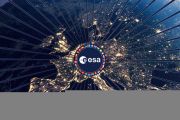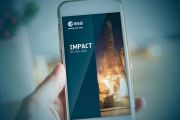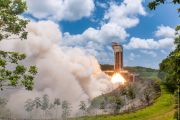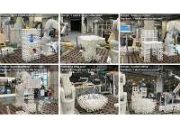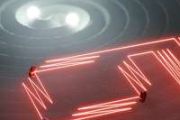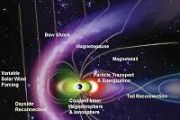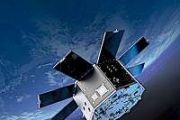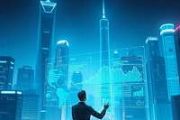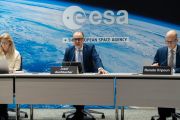
Copernical Team
Scientists unveil European Mars rover's meteorite-hunting instruments
 The ExoMars rover Rosalind Franklin, scheduled to launch in 2022, is tasked with hunting for past life on the Red Planet.
Most of the rover's scientific probing will be focused on the first six inches of Mars' crust, but the spacecraft will also be programmed to identify, sample and analyze meteorites strewn across the Martian surface.
Mission scientists unveiled the rover's mete
The ExoMars rover Rosalind Franklin, scheduled to launch in 2022, is tasked with hunting for past life on the Red Planet.
Most of the rover's scientific probing will be focused on the first six inches of Mars' crust, but the spacecraft will also be programmed to identify, sample and analyze meteorites strewn across the Martian surface.
Mission scientists unveiled the rover's mete SpaceX to launch NASA's Europa Clipper on Falcon Heavy rocket in 2024
 NASA on Friday awarded SpaceX the $178 million contract to launch the agency's Europa Clipper mission to study Jupiter's fourth-largest moon.
The mission is expected to depart October 2024 on the private aerospace company's Falcon Heavy rocket from the Kennedy Space Center in Florida.
"Europa Clipper will conduct a detailed survey of Europa and use a sophisticated suite of scienc
NASA on Friday awarded SpaceX the $178 million contract to launch the agency's Europa Clipper mission to study Jupiter's fourth-largest moon.
The mission is expected to depart October 2024 on the private aerospace company's Falcon Heavy rocket from the Kennedy Space Center in Florida.
"Europa Clipper will conduct a detailed survey of Europa and use a sophisticated suite of scienc NASA selects SpaceX for mission to Jupiter moon Europa
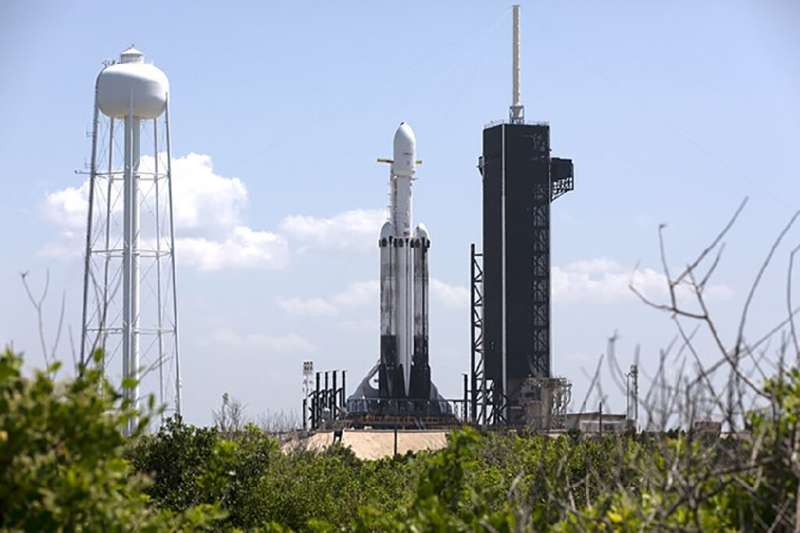
NASA on Friday said it had selected SpaceX to launch a planned voyage to Jupiter's icy moon Europa, a huge win for Elon Musk's company as it sets its sights deeper into the solar system.
The Europa Clipper mission will launch in October 2024 on a Falcon Heavy rocket from the Kennedy Space Center in Florida, with the total contract worth $178 million.
The mission was previously supposed to take off on NASA's own Space Launch System (SLS) rocket, which has been plagued by delays and cost overruns, with critics calling it a "jobs program" for the state of Alabama where much of the development work is taking place.
Artificial intelligence helps improve NASA's eyes on the Sun

A group of researchers is using artificial intelligence techniques to calibrate some of NASA's images of the Sun, helping improve the data that scientists use for solar research. The new technique was published in the journal Astronomy & Astrophysics on April 13, 2021.
NASA Awards Launch Services Contract for Europa Clipper Mission
 NASA has selected Space Exploration Technologies Corp. (SpaceX) of Hawthorne, California, to provide launch services for Earth’s first mission to conduct detailed investigations of Jupiter's moon Europa.
NASA has selected Space Exploration Technologies Corp. (SpaceX) of Hawthorne, California, to provide launch services for Earth’s first mission to conduct detailed investigations of Jupiter's moon Europa. Mini radar could scan the moon for water and habitable tunnels

A miniature device that scans deep below ground is being developed to identify ice deposits and hollow lava tubes on the moon for possible human settlement.
The prototype device, known as MAPrad, is just one-tenth the size of existing ground penetrating radar systems, yet can see almost twice as deeply below ground—more than 100 meters down—to identify minerals, ice deposits, or voids such as lava tubes.
Local start-up CD3D PTY Limited has now received a grant from the Australian Space Agency's moon to Mars initiative to further develop the prototype with RMIT University, including testing it by mapping one of Earth's largest accessible systems of lava tubes.
CD3D CEO and RMIT Honorary Professor, James Macnae, said their unique geophysical sensor had several advantages over existing technology that made it more suitable for space missions.
Keen to sign up for space tourism? Here are 6 things to consider (besides the price tag)

It's been a momentous month for space-faring billionaires. On July 11, British entrepreneur Sir Richard Branson's Unity "rocket-plane" flew him and five fellow passengers about 85 kilometers above Earth. And this week, Amazon founder Jeff Bezos' New Shepard capsule reached an altitude of 106km, carrying Bezos, his brother, and the oldest and youngest people ever to reach such a height. Passengers on both flights experienced several minutes of weightlessness and took in breathtaking views of our beautiful and fragile Earth.
Both flights created an avalanche of media coverage and brand recognition for Branson's Virgin Galactic and Bezos's Blue Origin. There is renewed anticipation of a lucrative commercial space tourism industry that could eventually see thousands of paying passengers journey into space (or not quite into space, depending on your preferred level of pedantry).
This year marks 60 years since Soviet cosmonaut Yuri Gagarin became the first human in space.
Laser research to boost deep space missions

Canberra is one step closer to being Australia's home to deep space laser communication, thanks to a government funding for researchers at The Australian National University (ANU).
Two ANU projects have received funding from The Australian Moon to Mars Demonstrator Feasibility Grants from the Australian Space Agency to help test new activities that will drive space exploration.
The first project will build a prototype deep space laser communications transmitter compatible with optical communication technology developed by NASA for missions including the Optical to Orion (O2O) demonstration, at a specialist facility in the ACT.
The facility could eventually be used by NASA to support deep space missions.
"This funding is going to allow us to build a prototype system compatible with future NASA missions which are going to deep space," project lead, ANU Associate Professor Francis Bennet, said.
A machine learning breakthrough: using satellite images to improve human lives
 More than 700 imaging satellites are orbiting the earth, and every day they beam vast oceans of information - including data that reflects climate change, health and poverty - to databases on the ground. There's just one problem: While the geospatial data could help researchers and policymakers address critical challenges, only those with considerable wealth and expertise can access it.
No
More than 700 imaging satellites are orbiting the earth, and every day they beam vast oceans of information - including data that reflects climate change, health and poverty - to databases on the ground. There's just one problem: While the geospatial data could help researchers and policymakers address critical challenges, only those with considerable wealth and expertise can access it.
No MDA Tech bridges gap between disparate sensors, fire control systems
 The Missile Defense Agency-developed Joint Track Management Capability (JTMC) and Open Systems Gateway (OSG) linked multiple sensor and fire control systems from multiple services into one integrated network during a July 15 flight test at White Sands Missile Range, New Mexico.
The integration led to the successful engagement of a cruise missile target by an Army Patriot Advanced Capabilit
The Missile Defense Agency-developed Joint Track Management Capability (JTMC) and Open Systems Gateway (OSG) linked multiple sensor and fire control systems from multiple services into one integrated network during a July 15 flight test at White Sands Missile Range, New Mexico.
The integration led to the successful engagement of a cruise missile target by an Army Patriot Advanced Capabilit 




